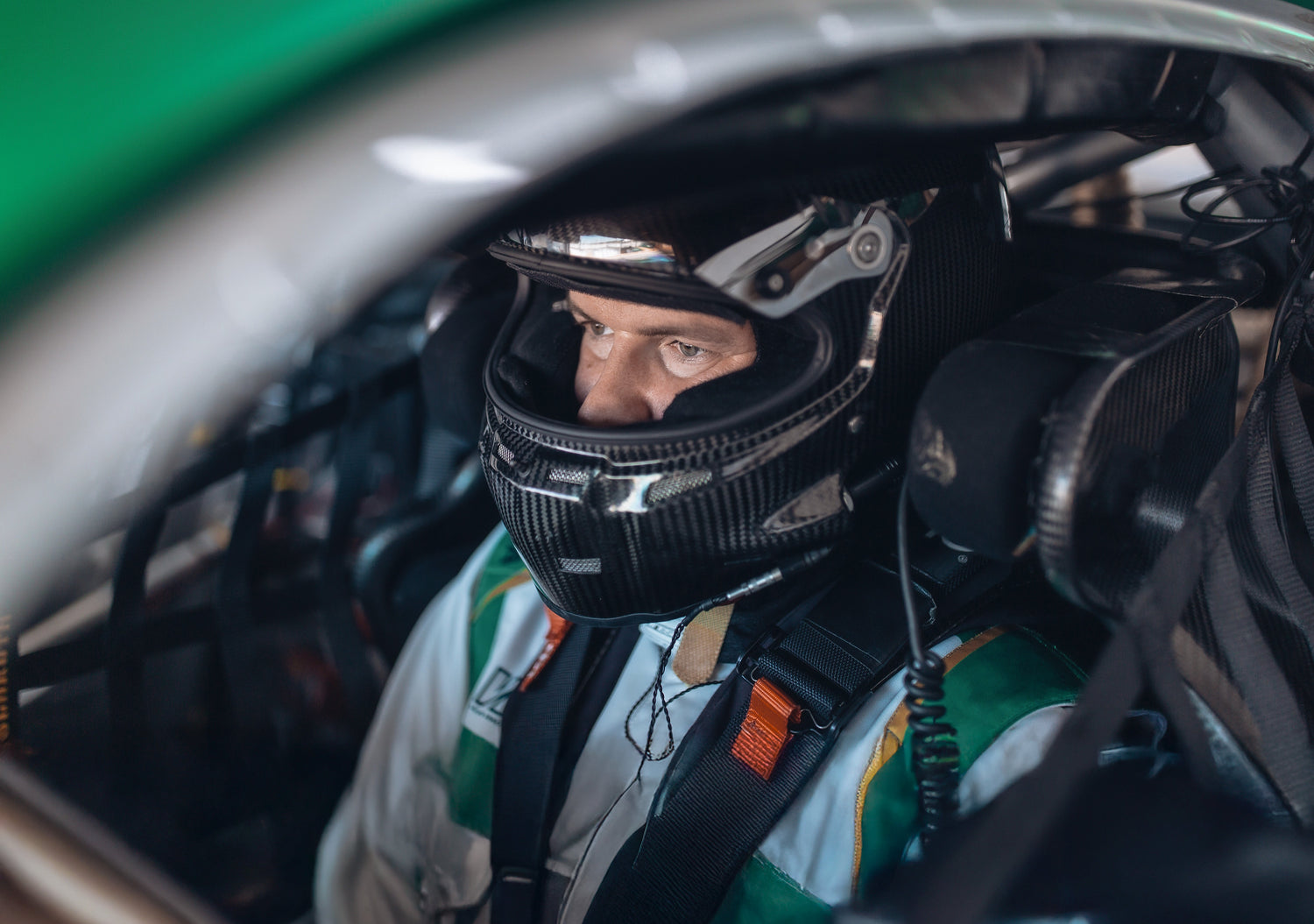Max Verstappen just held 200+ beats per minute heart rate for two straight hours while making split-second decisions at 200mph through the neon blur of Las Vegas. His body endured 5G forces that would knock you unconscious, all while maintaining the focus of a neurosurgeon and the reaction time of a mongoose fighting a cobra. Meanwhile, you're exhausted after one trip to Target for holiday shopping, your energy crashes at every family gathering, and the thought of maintaining your workout routine through Thanksgiving feels about as achievable as qualifying for pole position at Monaco. Here's the truth that should wake you up faster than turn one at Spa: The same biological systems that keep F1 drivers performing under impossible pressure are the ones failing you every holiday season, and you've been ignoring the science that could change everything.
Your Holiday Season Is an Endurance Race You're Losing
The parallels between F1 racing and holiday survival are more precise than you realize. Both involve sustained performance under extreme pressure, managing multiple stressors simultaneously, maintaining focus when fatigue sets in, and recovering between intense "sessions" whether that's qualifying rounds or family dinners. The difference? Verstappen has a team of scientists optimizing every aspect of his performance. You have Pinterest recipes and wishful thinking.
Research shows that chronic fatigue impairs reaction times and decision-making so severely that after just one week of holiday stress, your cognitive performance drops to the equivalent of being legally drunk (1). Yet somehow, you're expected to navigate Black Friday crowds, execute perfect gift selection, maintain social grace at multiple gatherings, and still hit the gym like nothing's changed. Your body is redlining like an F1 engine pushed beyond limits, but unlike those million-dollar machines, you don't have a pit crew monitoring your vitals.

The Biological Grand Prix Nobody Prepared You For
Let's break down what's actually happening to your body during the November-December gauntlet:
The Sustained Focus Crisis
F1 drivers maintain laser focus for hours through what scientists’ call "optimized perceptual-cognitive skills." A study on motorsport athletes found that elite drivers exhibit neural efficiency that allows prolonged attention under stress, processing multiple data streams while their bodies endure physical torture (2). Your holiday challenge requires the same sustained vigilance: tracking gift lists, managing social dynamics, coordinating schedules, maintaining work performance, all while your brain is flooded with cortisol that destroys the very focus you need most.
Research on cognitive fatigue in high-stakes environments shows that without specific training protocols, performance degrades exponentially after the first hour of sustained stress (3). That family gathering that starts at 2 PM? By 3:30, your brain has essentially given up, which explains why you agreed to host next year's dinner somewhere around dessert.
The Reaction Time Reality
Investigations reveal racing drivers have reaction times up to 20% faster than average humans, with motor responses honed through sport-specific adaptations (4). But here's what matters for you: those same studies show that holiday stress slows your reaction time by the exact same percentage in the opposite direction. You're literally operating at 60% capacity while trying to maintain 100% performance. No wonder you feel like you're driving through molasses while everyone else seems to be on fast-forward.
A simulator study revealed that time pressure can actually enhance stimulus-response behavior when properly managed, boosting physiological arousal for peak output (5). The key word there is "managed." Without proper biological support, that same pressure leads to burnout, crashed energy, and the inevitable holiday meltdown that has you hiding in the bathroom scrolling your phone while relatives wonder where you went.
The Pressure Performance Protocol
F1 drivers endure heart rates hitting 180 bpm and G-forces up to 5G, essentially experiencing a two-hour panic attack while performing precision tasks (6). Your holiday season creates the same physiological stress response, just stretched over six weeks instead of two hours. The psychiatric factors that determine success in F1 are identical to what you need: anxiety management, fatigue mitigation, and biohacked recovery that turns pressure into performance fuel.
The Vegas Victory Formula Applied to Your Life
When Lewis Hamilton prepares for Vegas, he doesn't hope for the best. He executes protocols refined by decades of sports science. Here's how to steal his strategies:
Morning Optimization Protocol
Start each day with Deep Wood for hormonal foundation. This isn't about getting jacked; it's about optimizing testosterone and cortisol balance to create sustained energy throughout your day. F1 drivers know that hormonal optimization determines whether you're sharp at lap 50 or falling apart. Taking Deep Wood with breakfast establishes the biological baseline that prevents afternoon crashes and evening exhaustion.
Pre-Event Activation Strategy
Before any high-stakes holiday event (family dinner, shopping marathon, office party), deploy Nitraflex Advanced like it's your pre-race ritual. The citrulline enhances blood flow like an F1 car's cooling system, beta-alanine buffers fatigue like high-performance brake fluid, and the nootropic blend delivers the cognitive edge of a perfectly tuned telemetry system. Take it 30 minutes before you need to be "on" and watch how differently you navigate social dynamics when your brain is firing at optimal frequency.
Inter-Event Recovery System
Creatine becomes your between-session secret weapon. F1 drivers don't just perform; they recover strategically between sessions. Creatine boost ATP when you're transitioning from work to shopping to socializing, maintaining cellular energy when everything else is depleting it.
The Demographic Breakdown of Holiday Performance
Gen Z (18-26): The Social Media Gladiators
Your generation documents everything while experiencing nothing, creating performance anxiety on top of actual performance demands. You're managing TikTok content creation while gift shopping, maintaining your "soft life" aesthetic while stressed beyond belief, and trying to look effortless when you're running on fumes. The F1 protocol gives you sustainable energy that photographs well and feels even better.
Millennials (27-42): The Obligation Olympians
Juggling aging parents, young kids, career demands, and somehow trying to maintain fitness through it all. You're the sandwich generation getting squeezed from both sides while expected to perform like you're still 25. The systematic approach of F1 preparation removes decision fatigue from your equation, giving you protocols that work whether you have time to think about them or not.
Late Gen X (43-48): The Endurance Veterans
You remember when holidays were simpler, but now you're managing multiple family dynamics, work responsibilities that never pause, and a body that doesn't recover like it used to. The F1 strategy acknowledges that experience matters but biological support matters more, giving you the tools to perform at elite levels regardless of age.
Your Personal Pit Crew Protocol
Morning Deep Wood sets your hormonal foundation for sustained performance throughout the day. This is your baseline optimization, the equivalent of an F1 car's setup configuration that determines everything else.
Pre-event Nitraflex Advanced taken 30 minutes before high-demand situations provides the acute performance boost when you need to be at your best. This is your qualifying lap preparation.
Inter-event Creatine maintains energy between demanding sessions, ensuring you don't deteriorate as the day progresses. These are your mid-race adjustments that keep you competitive.
Evening recovery with proper hydration and sleep becomes your overnight garage work, preparing you for tomorrow's demands. Track everything with HRV monitoring or simple energy ratings to ensure you're not redlining into breakdown.
The Checkered Flag Choice
Right now, you have two options for the holiday season ahead. Option one: Continue white knuckling through with willpower alone, accepting exhaustion as inevitable, and emerging in January wondering what happened to November and December. Option two: Apply the same scientific principles that allow humans to perform at impossible levels in F1, using proven protocols to turn holiday chaos into controlled performance.
The Vegas Grand Prix proves that humans can maintain elite performance under impossible conditions with the right support. Your holiday season is your personal grand prix, and you deserve the same scientific advantage.
Stop surviving the holidays. Start winning them.
References
- Baur H, Müller S, Hirschmüller A, Huber G, Mayer F. (2006). Reactivity, stability, and strength performance capacity in motor sports. British Journal of Sports Medicine, 40(11), 906-911.
- Potkanowicz ES, Ferguson DP. (2018). The Racer's Mind—How Core Perceptual-Cognitive Expertise Is Reflected in Deliberate Practice Procedures in Professional Motorsport. Frontiers in Psychology, 9, 1294.
- Beh HC, McLaughlin K. (2017). The effects of time pressure on driver performance and physiological activity: A driving simulator study. Transportation Research Part F: Traffic Psychology and Behaviour, 49, 38-50.
- Baur H, Müller S, Hirschmüller A, et al. (2006). Reactivity, stability, and strength performance capacity in motor sports. British Journal of Sports Medicine, 40(11), 906-911.
- Fowler PM, Paul DJ, Cropley B, et al. (2013). The Impact of Circadian Misalignment on Athletic Performance in Professional Football Players. Sleep, 36(11), 1677-1684.
- Janse van Rensburg DC, Fowler P, Racinais S, et al. (2020). How to manage travel fatigue and jet lag in athletes? A systematic review of interventions. British Journal of Sports Medicine, 54(16), 960-968.


